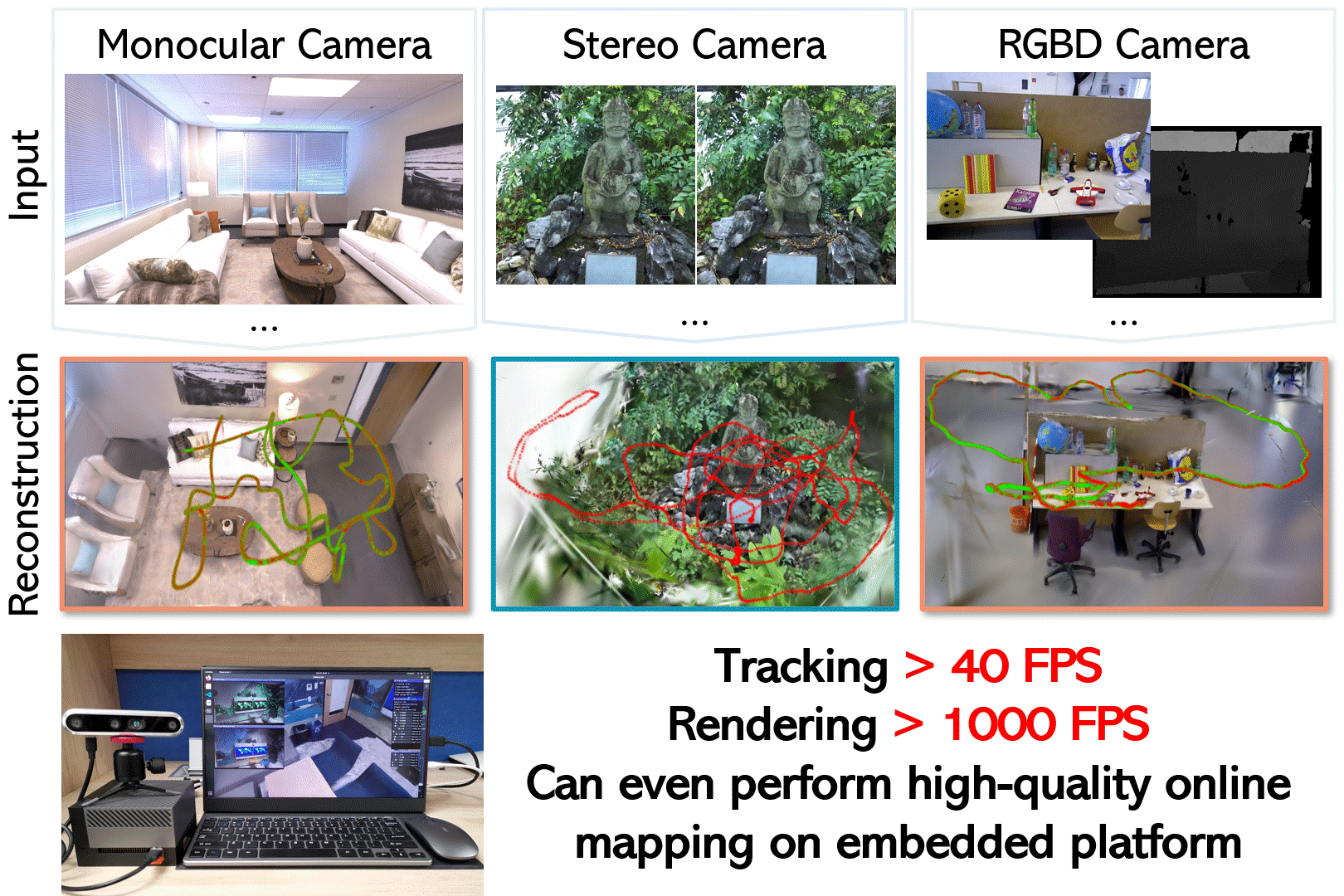Photo-SLAM: Real-time Simultaneous Localization and Photorealistic Mapping for Monocular, Stereo, and RGB-D Cameras
CVPR 2024
Huajian Huang1, Longwei Li2, Hui Cheng2 and Sai-Kit Yeung1
The Hong Kong University of Science and Technology1, Sun Yat-Sen University2

Abstract
The integration of neural rendering and the SLAM system recently showed promising results in joint localization and photorealistic view reconstruction. However, existing methods, fully relying on implicit representations, are so resource-hungry that they cannot run on portable devices, which deviates from the original intention of SLAM. In this paper, we present Photo-SLAM, a novel SLAM framework with a hyper primitives map. Specifically, we simultaneously exploit explicit geometric features for localization and learn implicit photometric features to represent the texture information of the observed environment. In addition to actively densifying hyper primitives based on geometric features, we further introduce a Gaussian-Pyramid-based training method to progressively learn multi-level features, enhancing photorealistic mapping performance. The extensive experiments with monocular, stereo, and RGB-D datasets prove that our proposed system Photo-SLAM significantly outperforms current state-of-the-art SLAM systems for online photorealistic mapping, e.g., PSNR is 30\% higher and rendering speed is hundreds of times faster in the Replica dataset. Moreover, the Photo-SLAM can run at real-time speed using an embedded platform such as Jetson AGX Orin, showing the potential of robotics applications.

How it works
1. Introduce the concept of hyper primitives map.
Hyper primitives are defined as a set of point clouds associated with ORB features, rotation, scaling, ensity,
and spherical harmonic (SH) coefficients. The hyper primitives map allows the system to efficiently optimize
tracking using a factor graph solver and learn the photorealistic mapping by neural solver.


2. Geometry-based densification.
We argue that 2D geometric feature points spatially distributed in the frames essentially represent the region
with a complex texture that requires more hyper primitives. However, less than 30% of 2D geometric feature points
of frames are active and have corresponding 3D points, especially for non-RGB-D scenarios. Therefore, we actively
create additional temporary hyper primitives based on the inactive 2D feature points.


3. Gaussian-pyramid-based learning, a new progressive training method.
Progressive training is a widely used technology in neural rendering to accelerate the optimization process.
Some methods have been proposed to reduce training time while achieving better rendering quality.
To enhance performance with efficient multi-level features learning online, we propose Gaussian-pyramid-based learning.
At the beginning training step, the hyper primitives are supervised by the highest level of the pyramid, i.e. level n.
As training iteration increases, we not only densify hyper primitives but also reduce the pyramid level and obtain a
new ground truth until reaching the bottom of the Gaussian pyramid.


Results
Comparisons
Live demos (No Speedup)
Citation
@inproceedings{hhuang2024photoslam,
title = {Photo-SLAM: Real-time Simultaneous Localization and Photorealistic Mapping for Monocular, Stereo, and RGB-D Cameras},
author = {Huang, Huajian and Li, Longwei and Cheng Hui and Yeung, Sai-Kit},
booktitle = {Proceedings of the IEEE/CVF Conference on Computer Vision and Pattern Recognition},
year = {2024}
}